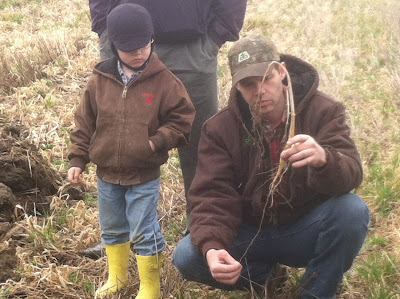by Cassandra Vondran
Cassandra is an Indiana State Department of Agriculture Resource Specialist for the Division of Soil Conservation in Allen and DeKalb Counties covering the Western Lake Erie Basin and has been with the Division for nearly 18 years.
Many benefits are associated with cover crops: erosion control, increased microbial
activity, increased nutrient cycling, increased organic matter, increased
infiltration, and increased crop yields. To educate area farmers, a cover crop
field day was held on April 10th at Ron Miller’s farm north of
Woodburn, IN. The field day was
sponsored by the Allen County SWCD as a part of an Indiana Department of Environmental
Management 319 grant for the Upper Maumee River Watershed Project.
 |
Scott Haley and Derek Thompson
showing soil health demonstrations
|
Scot Haley, NRCS Area Soil Scientist, and Derek Thompson,
DeKalb County NRCS District Conservationist, kicked off the field day by
showing soil demonstrations. Mike
Werling, a farmer and a contract employee through the St. Mary’s Watershed
Initiative, provided additional comments.
The demonstrations showed the benefits of utilizing cover crops. Producers
then were able to look at soil pits in fields that had cover crops.
 |
Attendees look on as Scott Haley
describes cover crop roots in a soil pit
|
Soil pits were dug about three to four feet
deep to allow producers the chance to see the below ground earthworm activity
and the roots of the cover crops. One
field was seeded with cereal rye and the other field was seeded with oilseed
radish and oats in the fall of 2012. Mr.
Miller received cost share assistance to try cover crops for one year.
 |
Ron Miller and his son look at
the roots of a dead oilseed radish plant
|
The takeaway message for the event was for farmers to
understand the basic mechanics of cover crops and adopt them into their own management
system. Events such as this cover crop
field day are giving farmers this basic information. More cover crop field days are being planned
for the future in Allen and DeKalb counties.




